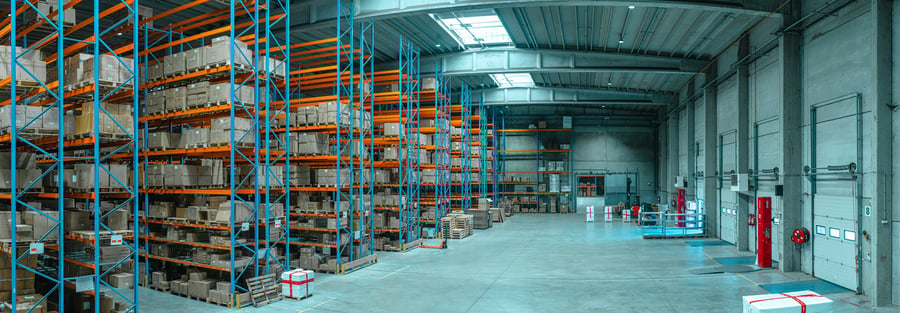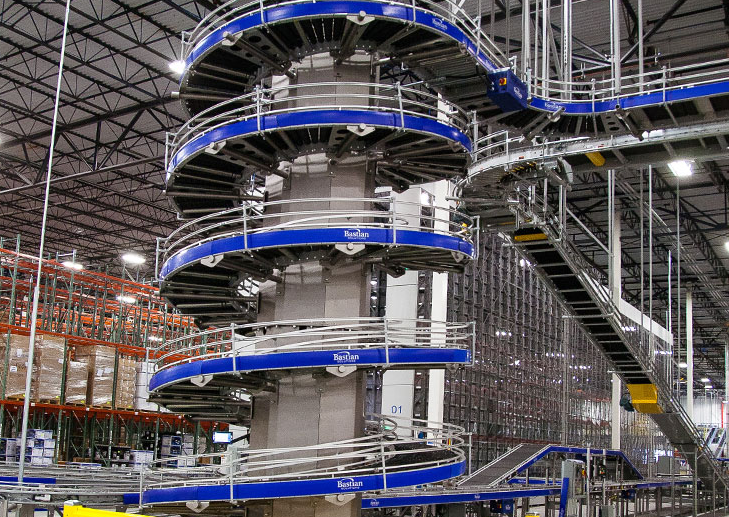
Improve the competitiveness of your distribution center through automation
In a world of rapidly changing markets and consumer behavior, the control and visibility of inventory, as well as the security of operations become crucial. Supply chains, made complex by the emergence of e-commerce and the omnichannel, require constant adaptation to meet changing consumer needs. In this context, the collaboration between Talan and Bastian Solutions, focusing on distribution center automation, is the strategic solution for improving your competitiveness.
Current challenges that our customers face
Space-related costs and warehouse management
Warehouse space management is a crucial component of modern logistics. With the ever-increasing cost of industrial real estate, maximizing the use of every square meter is becoming essential. This involves not only intelligent organization of physical space, but also the adoption of technologies such as automated storage systems and software solutions to optimize stock placement and movement.
Workforce: cost and availability
Workforce represents a significant proportion of a warehouse’s operating costs, often up to 60% of the total budget. The scarcity of skilled workforce, coupled with rising wage costs, poses a major challenge. In response, companies are turning to automation to reduce their dependence on workforce while increasing the efficiency and precision of operations.
Supply chain complexity
The rapid growth of e-commerce and the diversification of supply chains have considerably increased the complexity of logistics operations. Companies have to manage a wider range of products, shorter delivery times and higher customer expectations. This complexity requires careful planning, impeccable execution, and often the integration of advanced technologies to synchronize and optimize the various stages of the supply chain.
Geographical changes and supply chain lead times
The globalization of markets has led to significant changes in sources of supply, with suppliers and manufacturers spread all over the world. This means greater logistical challenges, particularly in terms of managing lead times and coordinating deliveries. The flexibility and the ability to adapt quickly to change are essential to keeping the flow of the supply chains.
Each organization faces its own challenges
Each organization faces unique challenges and questions that directly influence its performance and competitiveness. Efficient management of a distribution center or warehouse is not just a matter of organizing space, but encompasses a series of strategic issues that are essential to the operational health of the company. When current space becomes insufficient or inefficient, a global reorganization or relocation may be necessary.
Storage capacity and demand predictability
One of the first challenges is storage capacity. Do you need more space to meet growing demand, or is your current capacity under-utilized? The predictability of fluctuating and often unpredictable demand calls for flexible stock management. Managing stocks from international suppliers is also a major challenge, particularly when it comes to managing delivery times. Companies need to be able to quickly adapt their space and resources to market changes.
Shift management and operational effectiveness
In an environment moving towards a 24/7 economy, multi-shift order preparation is becoming the standard. This raises the question of operational effectiveness: Can your organization maintain consistently high productivity, regardless the shift? Similarly, operations requiring extreme conditions (cold or heat) pose unique ergonomic and safety challenges for workers.
Presentation of the TALAN - Bastian Solutions collaboration
Industrial engineering and technological innovation
At the heart of this collaboration is an in-depth expertize in industrial engineering, combined with advances in industrial site design and 3D simulation. This synergy enables companies to effectively visualize and plan optimized workspaces and automated processes, guaranteeing more efficient management and greater return on investment.
Architecture of your technological transformation
TALAN’s approach is based on a careful analysis of each organization’s specific needs and challenges. Feasibility studies and business cases are developed in parallel with an operational and technological vision, enabling detailed and adapted planning of an investment project. This methodology aims not only to improve current operations, but also to anticipate and prepare for future developments.
World-class collaboration and expertize
The strength of this collaboration lies in Talan’s supply chain performance team, which works with the best experts in the industry, including Bastian Solutions. As a subsidiary of Toyota Advanced Logistics, Bastian Solutions offers unmatched expertize in the design and implementation of advanced logistics solutions. This collaboration ensures that customers not only achieve significant improvements in their operations, but also gain a sustainable competitive advantage.
In short, the expertize of Talan and Bastian Solutions represents a strategic ally combining technical expertize, innovation and customization, aimed at transforming logistical challenges into opportunities for growth and efficiency for their customers.
Choosing the right technologies for your needs

In an economic context where the speed and precision of logistics operations are paramount, choosing the right automation technologies for a distribution center becomes crucial. There are several technological options, such as Automated Order Picking Technologies, Goods-to-Person systems, AutoStore, or AS/RS (Automated Storage & Retrieval Systems), offer a variety of solutions for optimizing stock management and order processing. The choice must be based on the nature and size of the products, storage and processing volumes, and the specific requirements of each company.
Automated Order Picking Technologies and Goods-to-Person Order Fulfillment revolutionize order picking and order preparation. Faced with increasing product flows and demanding customer expectations for rapid delivery, these technologies minimize human error and speed up processes. By automating order picking, companies can efficiently manage high order volumes while guaranteeing speed and precision.
Vertical Lift Modules (VLM) are particularly suitable for storing small and medium-sized products. These systems, similar to small automated cranes, optimize vertical space and ensure rapid retrieval of items. They are ideal for environments where floor space is limited, but height can be exploited.
Automated Storage and Retrieval Systems (AS/RS) distinguish themselves through their ability to handle large volumes of products. By integrating with warehouse management software, these systems provide a real-time overview of stocks, eliminating uncertainties and time-consuming physical inspections. They are essential in large warehouses with a constant flow of incoming and outgoing goods.
Finally, AutoStore represents an innovative solution for environments requiring great flexibility and a small space. Based on a structural grid with delivery robots, this modular system enables easy adaptation to changing business needs.
Automating distribution centers is not an end in itself, but a means of optimizing operations according to the specific needs of each company. The right selection of these technologies can radically transform the efficiency, accuracy and profitability of a supply chain.
Why automate your warehousing operations?

Automated warehousing operations are no longer a luxury, but a necessity. Automating your warehousing operations with our solution offers many benefits, far beyond simply reducing labor costs.
Order processing capacity and increased productivity
One of the most significant benefits of automation is improved order processing capacity. The machines can operate 24 hours a day, considerably boosting productivity. This ability to work without interruption enables us to handle a higher volume of orders, offering unprecedented responsiveness and efficiency in order preparation and shipping.
Reduced damage to stocks
The use of robots in the warehousing process minimizes product damage. These advanced technologies ensure more delicate and precise handling of items, reducing losses due to human error or accidents.
Improved ergonomics and safety for the workforce
By automating repetitive and physically demanding tasks, we improve ergonomics and safety in the workplace. This approach reduces the risk of injury and improves employee well-being, resulting in higher productivity and better staff retention.
Enhanced product safety
Automation also improves product safety. By better controlling storage conditions and reducing human error, product quality and integrity are preserved, which is essential in sectors such as food, pharmaceuticals and electronics.
Reducing labor costs
Finally, automation reduces labor costs, not only by reducing the need for staff for certain tasks, but also by repositioning this workforce towards higher value-added activities.
In conclusion, automating your warehousing operations generates a multitude of benefits, from increased productivity to better stock management, while ensuring the safety of products and staff. These improvements translate greater competitiveness and the ability to respond more effectively to the demands of today’s market.





